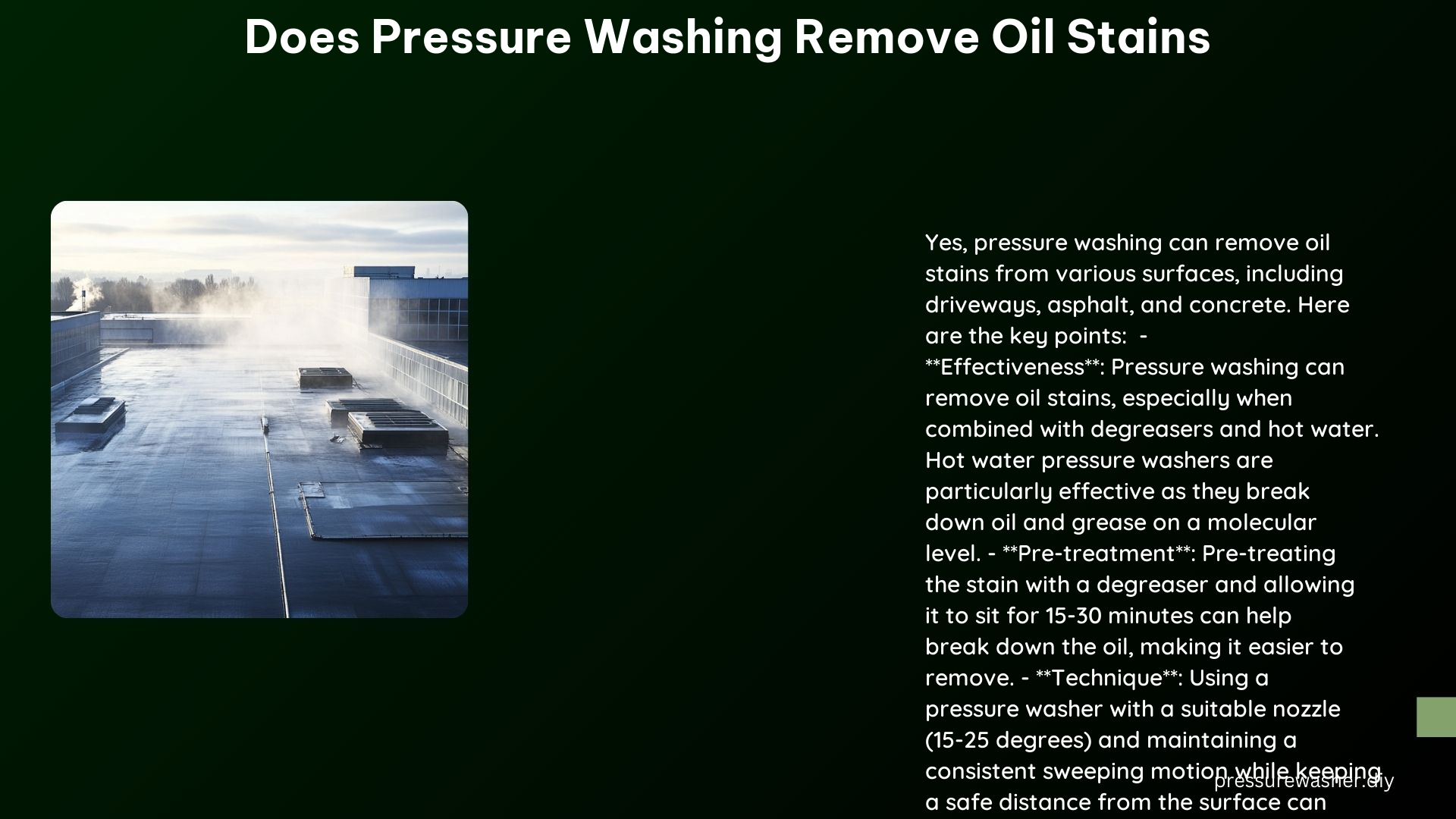Pressure washing can be an effective solution for removing stubborn oil stains from various surfaces, including driveways, pavements, and asphalt. However, the success of this method depends on several factors, such as the equipment used, the preparation of the surface, and the technique employed. In this comprehensive guide, we’ll explore the intricacies of pressure washing for oil stain removal, providing you with the technical specifications, best practices, and expert tips to ensure a successful outcome.
Effectiveness of Pressure Washing for Oil Stain Removal
Pressure washing is a reliable and widely-used method for removing oil stains, particularly on asphalt surfaces. The high-pressure water stream can effectively dislodge and lift the oil from the surface, making it an ideal choice for tackling these types of stains. However, the effectiveness of pressure washing can vary depending on the age and severity of the stain, as well as the porosity of the surface.
Preparation and Equipment Selection

Before pressure washing, it is crucial to pre-treat the stain with a suitable degreaser. This helps break down the oil, making it easier to remove during the washing process. Typically, degreasers should be allowed to sit on the stain for 15-30 minutes before pressure washing.
When it comes to equipment selection, the pressure washer’s PSI (pounds per square inch) and nozzle angle play a significant role in the effectiveness of oil stain removal. For this task, a pressure washer with around 3000 PSI and a 15-25 degree nozzle is often recommended. This combination of high pressure and a wide spray pattern can effectively dislodge and rinse away the oil without causing damage to the surface.
Pressure Washing Technique
The technique used during the pressure washing process is crucial for achieving optimal results. Start by washing from a safe distance, gradually moving closer to the stain if necessary. Maintain a consistent sweeping motion, avoiding focusing on one spot for too long, as this can lead to surface erosion.
The Advantage of Hot Water
Using a hot water pressure washer can be particularly effective against oil stains. The heat helps to dissolve and break down the oil, making it easier to remove. Hot water pressure washers can reach temperatures up to 311 degrees Fahrenheit, which is highly effective for cutting through grease and oil.
Post-Washing Considerations
After the initial pressure washing, it’s important to inspect the area for any remaining stains. If the stain persists, it may be necessary to apply a second round of degreaser and repeat the pressure washing process. Once satisfied with the results, thoroughly rinse the area to remove any residual cleaning agents or oil.
Environmental Responsibility
When pressure washing oil stains, it’s crucial to ensure that the runoff is contained and disposed of properly, in accordance with local regulations. This helps prevent environmental contamination and protects the surrounding ecosystem.
Regular Maintenance and Preventive Measures
To maintain the appearance and longevity of your surfaces, it’s recommended to regularly check for and address any new oil stains. Prompt attention and routine pressure washing can help prevent stains from setting in and becoming increasingly difficult to remove over time.
Professional Assistance
If you’re unsure about the best approach or lack the necessary equipment, it’s advisable to consult with a professional pressure washing service. They can assess the situation, recommend the appropriate equipment and techniques, and ensure the job is done safely and effectively.
Additional Cleaning Methods
In some cases, pressure washing alone may not be sufficient to fully remove stubborn oil stains. In such instances, additional cleaning methods, such as using poultices or specialized cleaning agents, may be necessary. It’s always best to consult with a professional to determine the most effective approach for your specific situation.
Technical Specifications
- Pressure Washer PSI: 3000 PSI is typically effective for oil stain removal.
- Nozzle Angle: A 15-25 degree nozzle is often used for stain removal without risking damage to the surface.
- Hot Water Temperature: Hot water pressure washers can reach temperatures of up to 311 degrees Fahrenheit, which is effective for breaking down oil and grease.
Best Chemicals for Oil Stain Removal
- Degreasers: Suitable degreasers, such as Oil Eater and chain degreaser, can be used to pre-treat the stain before pressure washing.
- Enzymatic Detergents: These can be used in conjunction with pressure washing to break down and remove oil stains.
- Muriatic Acid: This can be effective but requires caution and proper disposal to avoid environmental harm.
DIY Tips
- Clear the Area: Remove any obstructions and debris before pressure washing to ensure a clear and unobstructed work area.
- Soak Up the Stain: Use an absorbent material like kitty litter or clay to soak up as much of the oil as possible before pressure washing.
- Use a Good Detergent: Choose a suitable detergent that is environmentally friendly and effective against oil stains.
